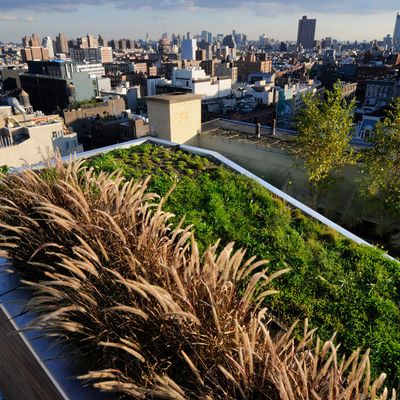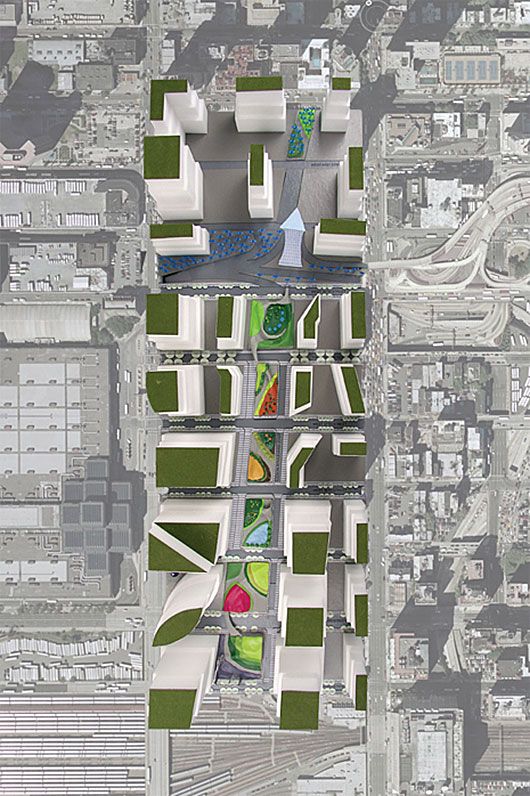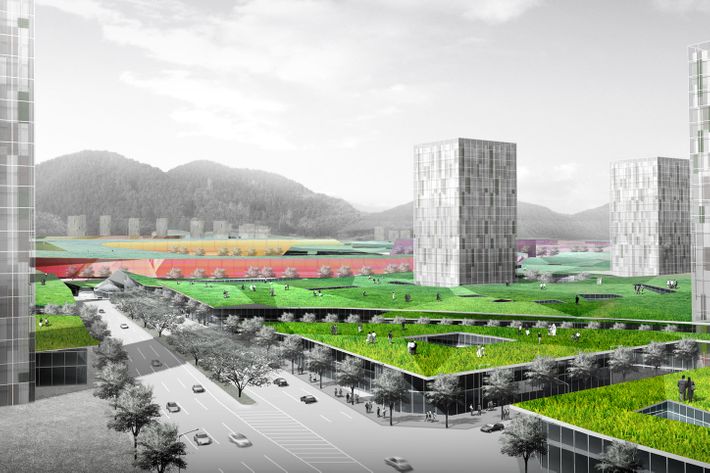
This week, Daily Intel profiles five inventors with big ideas that could make life a little bit better and more interesting for everyone.
If you wanted to illustrate the concept of abandonment and decay, you could hardly do better than an image of an overgrown city, with roots smashing through asphalt, tendrils sneaking over thresholds, and streams cascading down escalators. Nature and the city are supposed to remain on their respective sides of a notional border, and when they don’t, the outcome is at once picturesque and disturbing. And so in cities, we have confined trees to their square holes in the sidewalk and hardened shores against rivers and seas. We have spent untold billions to make sure that nature doesn’t enter uninvited, and that our urban centers remain impermeable, sharp-edged, level, and dry.
But the New York of a couple of decades from now could be greener by design, a city where patches of planned wilderness infiltrate the architecture, by invitation, not neglect. Imagine a pedestrian pathway running through tended grasslands in the center of Broadway; Canal Street reconverted back to a canal; farmers harvesting kale in Washington Square or on the 20th floor of a vertical hothouse; roof gardens fertilized with local compost; a convention center that sits beneath a forested hillside; skyscrapers that use water from showers, tubs, and sinks to irrigate balcony arbors and planted walls; midtown streets shaded by hanging vines.
It’s not that far-fetched. “Look at the East Village,” says the architect Amale Andraos. “On almost every street, you have a garden, maintained partly by the city and partly by the community, which drops the temperature, grows food, and provides shared space. That model of integration is very simple and also quite radical.”

Andraos, who founded the firm Work AC with her husband Dan Wood, recently became one of the most powerful women in urbanism when she was named dean of Columbia’s Graduate School of Architecture, Planning, and Preservation. Her fantasies have an institutional imprimatur. This may be speculative daydreaming, but it’s respectable daydreaming. This bucolic future Gotham is one that has responded sensibly to the realities of climate change. Wave-calming wetlands and outboard islands protect a nature-besotted city. In times of rain, designated streets become temporary spillways, absorbing, storing, and cleaning floodwater, then releasing it in a regulated flow. Summers are mild, storms are kind, and the air is pure.
She has plenty of company in imagining an environmentally virtuous city where concrete and greenery exist in sustainable harmony. The landscape architect Diana Balmori has linked the roofs of 21 ministries in the new Korean center of Sejong with a three-mile planted walkway, not unlike the High Line, that she hopes will breed a new pedestrian infrastructure. (She was also a collaborator in Work Architecture Company’s “Wild West Side” proposal to create a radically green neighborhood on the Hudson Yards site.)
“Why not take over city streets just as we’ve taken over railroad lines for linear parks?” Balmori asks. “It’s only a step away from what we’ve already done.” Now she’s campaigning to widen and landscape the Broadway median from 72nd to 136th Street, creating a path equipped with solar panels and turbines powered by the wind from passing cars.
Nature has already made significant inroads into the concrete jungle. Green roofs are proliferating, retaining storm water and then releasing it into buildings’ plumbing. Parking lots are becoming porous. The High Line has demonstrated the power of the landscaped pedestrian artery. In the Brooklyn Botanical Garden, the firm Weiss Manfredi enfolded a new visitor center in turf, and in Prospect Park, Tod Williams and Billie Tsien have nestled the Lakeside skating complex into the park’s natural topography.

Greening the city is not just a New York effort. In Los Angeles, the landscape architect Mia Lehrer has been leading a long-term push to turn the desiccated L.A. River into a new park system’s lush spine. Also in L.A., the Trust for Public Land has been pushing a plan to turn 900 miles of alleyways into a web of microparks. In Milan, the Italian architect Stefano Boeri has just completed the pair of verdant apartment towers he calls the Vertical Forest. And long before these adventurers were even born, Frank Lloyd Wright insisted that landscape and architecture were indissolubly coupled and that good design took its cues from nature.
Andraos and Balmori both know that it will take a long time for these isolated efforts to link up into the parkland metropolis they envision. But they’re confident that one day vines, grasses, crops, and water will be just as intrinsic to the New York experience as miles of hard gray asphalt. And, since successful experiments quickly get replicated all over the world, a greener Manhattan could yield a more vegetative Buenos Aires and Mumbai. This matters because, as more and more of the world’s billions converge on growing metropolitan regions, the planet’s health depends on more breathable cities. An abundance of nature makes urban life prettier and more pleasant; it might also save the world.






























